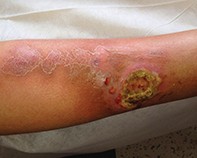Unwanted souvenirs – a leg ulcer and nasal ulceration in a returned traveller from South America
- Should all persistent skin ulcers after travel to South or Central America be considered due to cutaneous leishmaniasis?
Six months later, Sam presented with new nasal congestion and erythema. Nasal examination revealed erythematous swelling and septal crusting (Figures 2a and b).
- Could the patient’s nasal symptoms be related to his apparently cured leishmaniasis?
Mucocutaneous leishmaniasis was confirmed on nasal biopsy. Intravenous liposomal amphotericin B and pentavalent antimony (pentostam) were trialled but both were curtailed because of side effects (pancreatitis, hepatitis and renal failure). He was eventually cured, after the nasal congestion worsened, with the new oral antiprotozoal drug miltefosine.
Case scenario
Sam, aged 52 years, initially presented with a persistent leg ulcer 10 weeks after travelling to jungle parts of Bolivia where he recalled having had multiple sandfly bites (Figures 1a and b). He had had recurrent treatment courses of antistaphylococcal antibiotics without any improvement. After advice from an infectious diseases physician, cutaneous leishmaniasis was confirmed on biopsy. Treatment with intravenous liposomal amphotericin B resulted in eventual complete healing of the ulcer.

